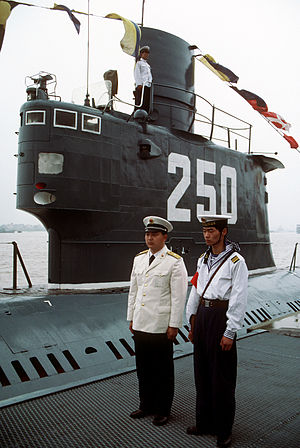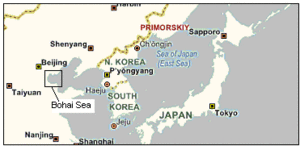- Chinese submarine 361
-
An officer and sailor stand next to the conning tower of a Ming class submarineCareer (China) 
Name: No. 361 Fate: Lost 16 April 2003 General characteristics Class and type: Ming-class submarine Displacement: 1,584 tonnes (1,559 long tons) surfaced
2,113 tonnes (2,080 long tons) submergedLength: 76 m (249 ft 4 in) Beam: 7.6 m (24 ft 11 in) Draft: 5.1 m (16 ft 9 in) Propulsion: 2 × Shaanxi 6E 390 ZC1 diesels rated at 5,200 hp (3.82 MW)
2 × Xiangtan alternators
2 shaftsSpeed: 15 knots (28 km/h) surfaced
18 knots (33 km/h) submergedComplement: 55 (9 officers) Armament: 6 × bow torpedo tubes
2 × stern torpedo tubesThe submarine hull number No. 361 with name Great Wall # 61 (长城61号) is a Chinese People's Liberation Army Navy Type-035AIP (ES5E variant) (NATO reporting name Ming III) conventional diesel/electric submarine. It was reported to have suffered an accident killing all on board in 2003 while at the Bo Hai Sea between North Korea and eastern Shandong Province of China.
No. 361 was part of the 12th Brigade of the North Sea (Bo Hei) Fleet of the PLAN based at Lu Shun (formerly Port Arthur) in the Liao Ning Province.
The loss of the crew of submarine No. 361 is the worst declared peacetime military disaster in the history of the People's Republic of China.
Contents
Ming class
The Ming class of Chinese submarines are an adaptation of the diesel/electric Romeo class submarine built in the Soviet Union, which are based on the German Type XXI submarine of World War II.
The Central Military Commission ordered the building of the Ming class submarines in 1967 as Project 035. The construction of the first began during October, 1969 at Wuhan Shipyard. The last boat was built in 2002. A total of 20 boats were built, of which 17 are left, and most serve in the North Sea Fleet. No. 361 serving the East Sea Fleet was the thirteenth and was built in 1995 making it one of the newest in the fleet.
CNN reports that China is increasing training and exercises of its submarines in the east to carry out a policy of "sea denial" to try counter the powerful U.S. Pacific fleet [1]. The location of the incident (see below), the Bo Hei Sea is very strategic for China. It is the closest sea outlet to Beijing, and one of the busiest sea routes in the world.
Incident
According to the official Chinese news agency, Xinhua, the submarine was taking part in exercises east of Neichangshan islands in the Bo Hai Sea (渤海) of Northeastern China. [2]. The captain of the boat was (Naval) Senior Colonel (equivalent of a commodore) Cheng Fuming (程福明). Among the 70-member crew, 13 of them were not part of the original crew, but instead, trainees and cadres from the naval academy.
On April 16, 2003, all 70 crew members of the submarine were killed when the diesel engine failed to shut down when the boat submerged and used up all the oxygen in the boat.
According to Xinhua on May 2, 2003, the crippled boat was discovered by Chinese fishermen on April 25, 2003, when they noticed the periscope sticking out. The submarine was then towed initially to Yulin on Hainan Island, and later towed back to the northeast seaport of Dalian. The submarine was drifting for ten days because it was on a silent, no-contact drill.
Mystery
A number of issues arose with this incident:
- Michael McGinty, an expert on the Chinese navy at the Royal United Services Institute for Defence Studies in London and a former British submariner[3], said "The accident likely happened while the submarine was on the surface. If the accident happened when the boat was under water, it was less likely China could have recovered it." This contradicts the official version that the submarine was submerged.
- One leading theory for the accident is called engine run-on casualty. This happens when the diesel engines are still running while the submarine is submerged, instead of switching to electric motors. This results in the diesels sucking oxygen out of the inside of the submarine, suffocating the crew. But this is dismissed because the original Russian design of this submarine has a device that cuts off diesel fuel supply to the engines if it detects a drop in barometric pressure inside the hull.
- Another theory is that seawater seeped into the batteries creating a toxic environment via deadly chlorine gas that could kill an entire crew while on the surface. Again, chlorine gas does not kill instantly. Chlorine gas also has a very distinctive smell.
- Other military commentators also pointed out that the sea water outside of the Liaodong Peninsula was only one to two hundred meters deep, which was considered shallow for a submarine.
- Also, all submarines have multiple escape hatches. So the inability of any of the crew to escape is also considered puzzling.
- The Chairman was shown visiting the submarine at Dalian during the first week of May. The submarine was very clean during the visit, which made observers wonder if it were the original.
- The usual complement of a Ming-class submarine is 9 officers and 46 crew. So the existence of 15 additional personnel onboard is puzzling, but may be related to the exercises. It has been speculated that the submarine was testing an AIP system when the accident occurred.
- When the flap valve, fitted to the snorkel which sucks in the oxygen, shuts in response to water being sucked into the snorkel it causes a temporary pressure drop in the submarine. This change in pressure is quite noticeable, for example your ears will pop and you might feel that your head is swelling. This generally can happen for short periods of time. However, if the diesel engines were running the crew would have known this was happening and should have been able to don EBS (emergency breathing system) if fitted. This is the first emergency procedure taught to new recruits to a submarine.
Impact
CMC Vice-chairman Guo Boxiong led an enquiry into the incident, which resulted in the dismissal of four senior PLAN officers, Navy Commander Shi Yunsheng, Political Commissar Yang Huaiqing, North Sea Fleet Commander Ding Yiping (丁一平), and North Sea (Bei Hai) Fleet Political Commissar Chen Xianfeng (陈先锋) on June 13, 2003. Another four senior officers were also demoted. The official verdict was improper "command and control".
Quotes
- "The officers and sailors of 361 remembered their sacred duty entrusted to them by the Party and the People. They died on duty, sacrificed themselves for the country, and they are great losses to the People’s Navy." - Chairman Jiang Zemin, Central Military Commission in a condolence message to families of the dead, 2 May 2003.
External links
- Type 035 (Ming Class) Diesel-Electric Submarine
- Chinese Submarine Accident Kills 70 (Taiwanese Security Research)
- includes a picture of 361
- China sub deaths 'must rouse Navy' (BBC News)
- Sackings after China's sub disaster (BBC News)
- China sub victims 'suffocated' (BBC News)
- HK press seeks answers to sub accident (BBC News)
- Picture of Submarine 361
Categories:- Ming class submarines
- Ships built in China
- 1995 ships
- Chinese submarine accidents
- Maritime incidents in 2003
Wikimedia Foundation. 2010.


